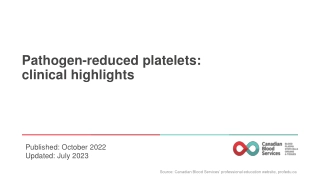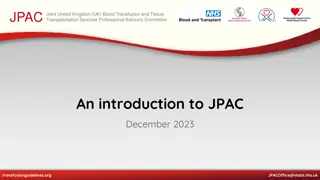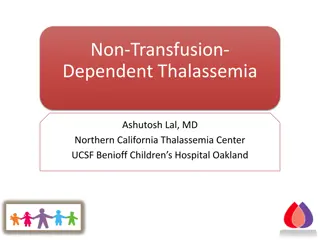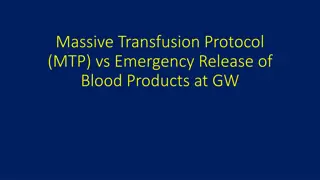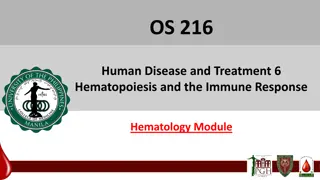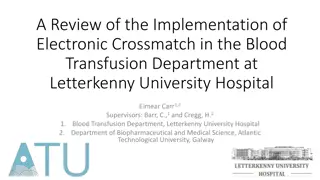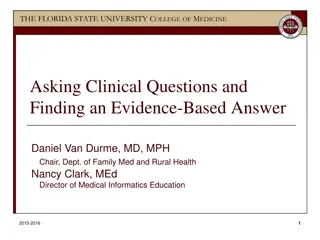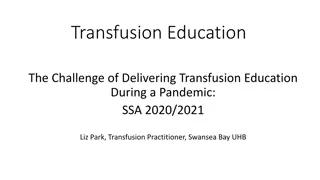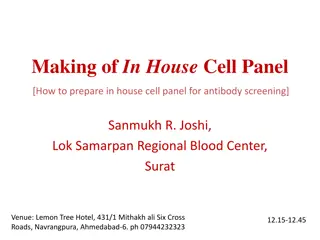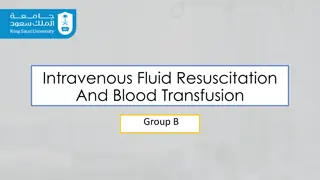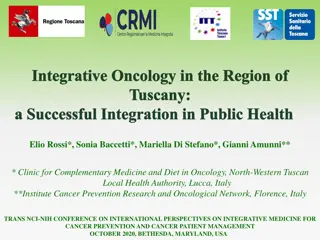Unlocking the Clinical Significance of Alloimmunization in Transfusion Medicine
Alloimmunization, a critical side effect of transfusion, has been a challenge in matching phenotypes and genotypes globally. The detection of clinically significant antibodies requires a delicate balance between sensitivity and specificity, considering various controllable and uncontrollable variables. Once antibodies are detected, identifying specificity is crucial for predicting clinical significance based on characteristics such as antigen density, complement fixation ability, and immunoglobulin class.
Download Presentation

Please find below an Image/Link to download the presentation.
The content on the website is provided AS IS for your information and personal use only. It may not be sold, licensed, or shared on other websites without obtaining consent from the author. Download presentation by click this link. If you encounter any issues during the download, it is possible that the publisher has removed the file from their server.
E N D
Presentation Transcript
Clinical Significance All or nothing? Or is there a grey zone? Paul Aerts Scientific Affairs Manager 1
Alloimmunization: a side effect of transfusion The 1st documented human transfusion 1795, Philadelphia USA In Europe James Blundell in 1818 was the first to be mentioned to treat a postpartum hemorrhage with a transfusion Fewer than 10% of first-time RBC recipients alloimmunize Up to 40% of multiply transfused patients do alloimmunize And only a fraction may destroy a fraction or all of the transfused RBC alloimmunization is a -significant- side effect of tranfusiom 2
Remarkably ! Looked at it on a worldwide scale This significant side effect has not led to what would be a logic goal of phenotype matching and/or genotype matching 3
Let us look again at The definition of a clinically significant antibody An antibody capable of causing accelerated destruction of a significant proportion of transfused cells An antibody capable of crossing the placenta and causing haemolytic disease of the foetus and newborn (HDFN) 4
The challenge To be able to detect only clinically significant antibodies But not those that have no clinical importance "noise" Balance between sensitivity & specificity Controllable variables: Temperature, incubation, ionic strength, pH, Uncontrollable variables: "the patient" 5
Once an antibody is detected Exclude underlying allo-antibody Auto-antibody Antibody Identify specificity Allo-antibody 6
Once the antibody specificity is clear Can predict clinical significance based on characteristics of the antibody and the corresponding antigen: Inhibited by blood group substances? Antigen density on the red cell surface Ability to fix complement Affinity and avidity of the antibody Immunoglobulin (Ig) class (IgG 1, 2, 3, 4 / IgM) Thermal range 7
Exceptions Serological transfusion reactions rather than evidence of significant haemolysis after transfusion of incompatible blood (even including ABO) DSTR Atypical examples of some specificities, not generally considered clinically significant, e.g. anti-Leb, are in very rare cases implicated in a haemolytic transfusion reaction. 9
Exceptions Unsafe to assume that the usual suspects will be harmless + Significant exceptions are rare = Pragmatic approach required to design pre-transfusion protocols Focus resources on testing the most likely to improve patient safety 10
Specificity Probability of significance is based on historical evidence Correct antibody identification important positive identification and exclusion Strong evidence that some antibody specificities can cause haemolytic transfusion reactions (HTR), e.g. anti-D For some other specificities, e.g. anti-M the evidence is not so clear 11
BSH guidance based the UK population Likely clinical significance in transfusion Recommendation for selection of red cells for transfusion * System Specificity Rh Anti-D, -C, -c, -E, -e Yes Antigen negative Kell Anti-K, -k Yes Antigen negative Kidd Anti-Jka, -Jkb Yes Antigen negative MNS Anti-M (active 37oC) Yes Antigen negative MNS Anti-S, -s, -U Yes Antigen negative Duffy Antigen negative red cells should also be compatible in an IAT crossmatch Anti-Fya, -Fyb Yes Antigen negative 12
BSH guidance based the UK population Likely clinical significance in transfusion Recommendation for selection of red cells for transfusion * System Specificity Diego Anti-Wra (anti-Di3) Yes IAT XM compatible Rh Anti-Cw No IAT XM compatible Kell Anti-Kpa No IAT XM compatible MNS Anti-M (not active 37oC) No IAT XM compatible at 37oC MNS Anti-N No IAT XM compatible at 37oC P Anti-P1 No IAT XM compatible at 37oC Lewis Anti-Lea, -Leb, -Lea+Leb No IAT XM compatible at 37oC Lu Anti-Lua No IAT XM compatible at 37oC ABO Anti-A1 No IAT XM compatible at 37oC H Anti-HI (in A1 and A1B) Others by IAT 37oC No IAT XM compatible at 37oC All Yes Seek reference centre advice 13
Thermal Range Apart from ABO antibodies, those non-reactive above 30oC are rarely clinically significant noentry Warning about warming! Pre-warming techniques used where antibody specificities have been fully identified otherwise risk missing: rare but significant antibodies with variable reactivity at 37oC, e.g. anti-Vel 14
In-vitro = in-vivo ? In-vitro testing only predicts clinical significance, but actual significance depends on the activity of the individual recipient s immune system. in-vivo red cell survival studies such as transfusing small volumes of Cr51 labelled red cells Cellular (functional) assays, such as the monocyte monolayer assay (MMA) Valuable information specific to individual case Time consuming and complex, so not routine 15
Antibody screening Detect as many antibodies with potential clinical significance as possible whilst not detecting antibodies with little or no clinical relevance 16
Inherent differences in IAT technology Solid phase CAT Tube Difficult to automate Agglutination phase, so some IgM detected even if anti-IgG AHG used Easy to automate Adherence of cell membranes to wells, so no agglutination phase Detects IgG only May detect enzyme only antibodies Easy to automate Agglutination phase, so some IgM detected even if anti-IgG AHG used 17
AHTR Fever XM Timing Hb LDH Bilirubin DAT hemolysis confirmed by one or more AHTR < 24 hrs AND pos pos hemolysis confirmed by one or more Pos but neg pre transfusion failure to increment DHTR > 24 hrs AND OR DSTR development of antibody BUT no clinical or lab evidence of hemolysis pos/neg 18
Not all antibodies have the destruction potential Antibody specificity E Jka Fya K c C Jkb Fyb e Total N 184 95 62 62 54 22 17 12 12 DHTR n DSTR n 47 45 26 16 18 8 3 4 3 DSTR 74% 53% 58% 74% 67% 64% 82% 67% 75% 137 50 36 46 36 14 14 8 9 Garratty G. Do we really understand immune red cell destruction? Transfus Med 2008;18:321-334 Total 559 197 362 65% 20
Conclusions Impossible to predict clinical significance 100% and eliminate all noise Interpret in the patient s clinical context Optimise your screening Identify specificity correctly 21



